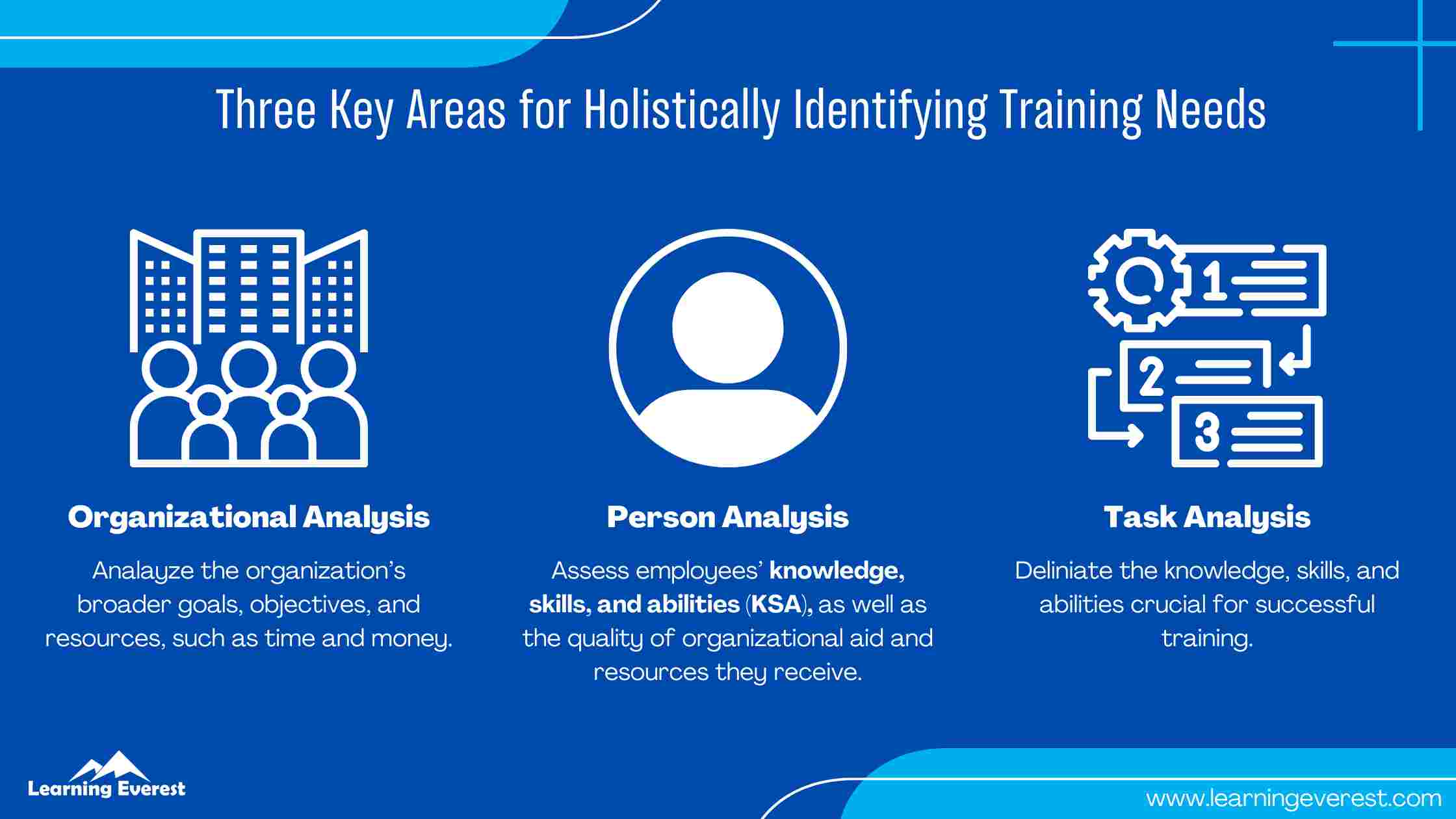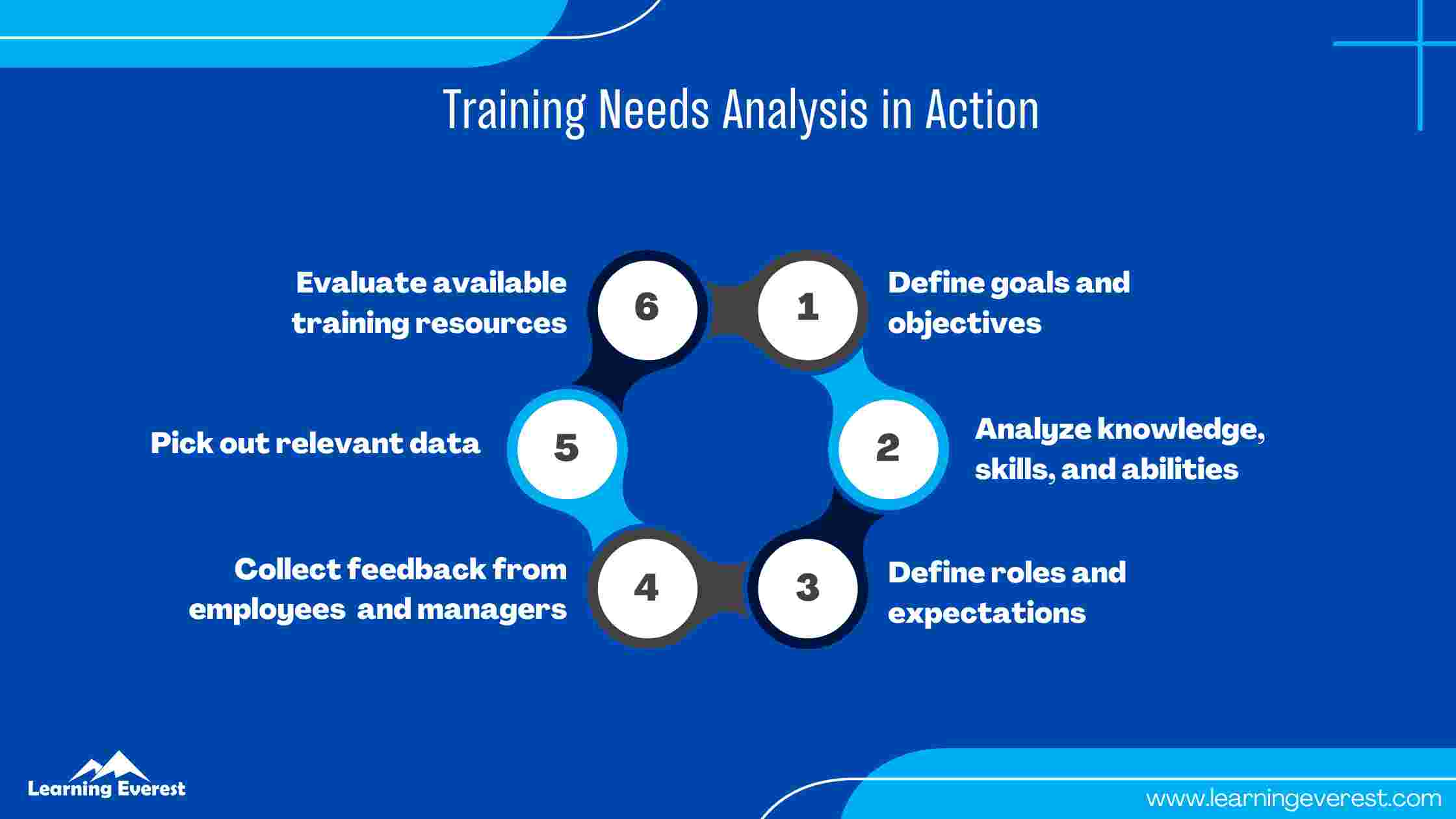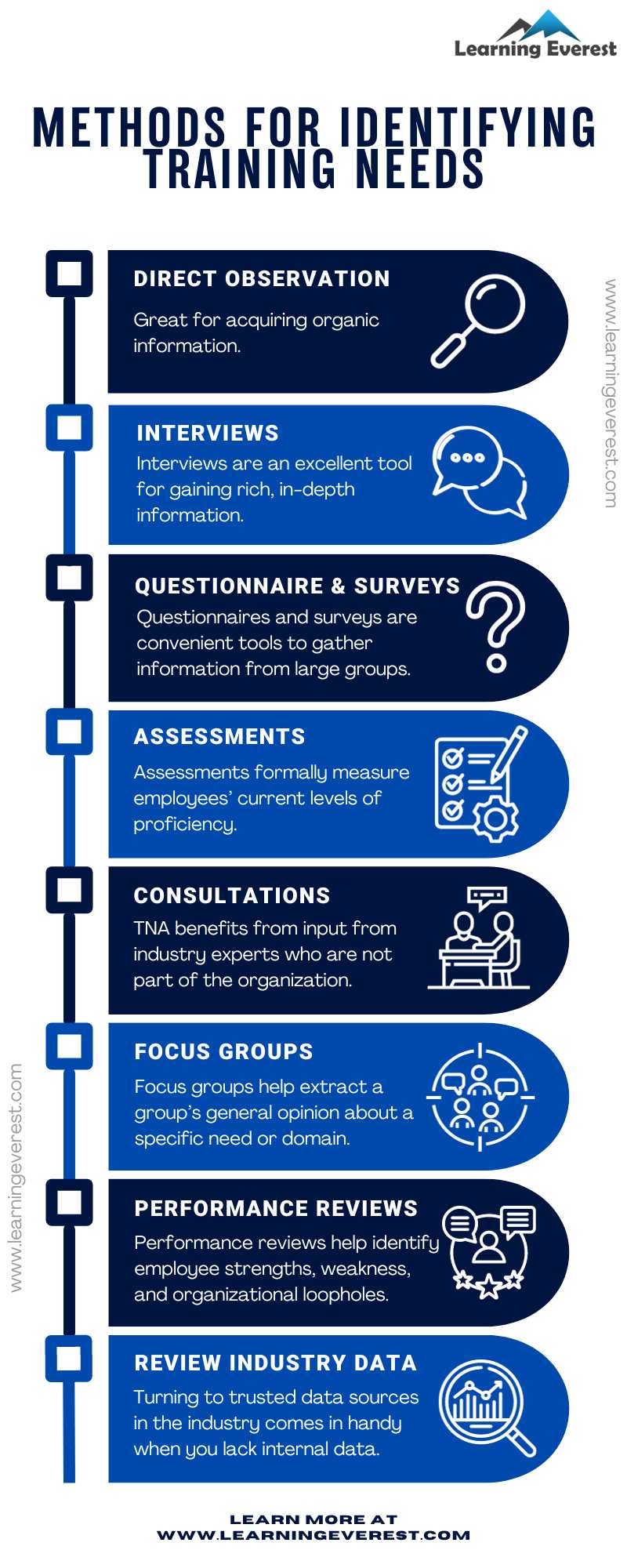Identifying training needs can be an overwhelming task without the proper methods at one's disposal. Having a basic training needs identification strategy can, thus, come in handy for organizations in the long run. Since training and development are integral parts of a company's overall functioning, they occur in some capacity throughout an enterprise's lifecycle. A structured process called training needs analysis (TNA) is usually carried out whenever a new goal or discrepancy arises. The following sections will explore how to assess training needs by highlighting the methods used.
Table of Contents
- Here are some valuable methods for identifying organizational training needs
- Here are some valuable methods for identifying organizational training needs
- Methods used for identifying training needs
- Putting it all together
- Infographics
- Knowledge Check!
- Frequently Asked Questions (FAQs)
- What do you mean by identification of training needs?
- What are the three levels of training needs analysis?
- What are the strategies of training needs analysis?
Here are some valuable methods for identifying organizational training needs
Identifying training needs using TNA
TNA is broadly conducted in two scenarios:
- When there is a gap between actual and expected employee and organizational outcomes.
- When a company’s operational capacity is expanding to accommodate new skills and abilities
In the former situation, TNA aims to measure training and skill gaps, if any. TNA evaluates the current baseline of employees’ familiarity, ability, and aptitude for the new skill to deliver an appropriate program in the latter scenario.
Here are some valuable methods for identifying organizational training needs
Identifying training needs using TNA
TNA is broadly conducted in two scenarios:
- When there is a gap between actual and expected employee and organizational outcomes.
- When a company’s operational capacity is expanding to accommodate new skills and abilities
In the former situation, TNA aims to measure training and skill gaps, if any. TNA evaluates the current baseline of employees’ familiarity, ability, and aptitude for the new skill to deliver an appropriate program in the latter scenario.
TNA examines three key areas to arrive at a holistic conclusion about the kind of approach to take. These are:
- Organizational Analysis: The organization’s broader goals, objectives, and resources are first assessed. Organizational goals pertain to the organization’s size, the industry it is in, overall productivity, growth trajectory, introducing new departments and shutting down old departments, technological changes, etc. The most important resources considered in this area are money, time, and infrastructure.
- Person Analysis: This domain evaluates individual employees and teams to determine their readiness for training and the kind of training they will need. Employees’ knowledge, skills, and abilities (KSA) are assessed, along with their motivation levels and the quality of organizational aid and reinforcements they receive.
- Task Analysis: Task analysis helps define the knowledge, skills, and abilities that should be the focus of training. These decisions are based on the skills gaps observed in the employees and feedback from managers and SMEs.

Three Key Areas for Holistically Identifying Training Needs.
Methods used for identifying training needs
The aim of analyzing the organization, its people, and the task in TNA is to gather data that can then guide the direction the training will take. Thus, all domains involve data collection of one kind or another. Depending on the kind of information being sought, the following methods are typically used:
- Direct observations: This is one of the best ways to acquire organic information about how an organization, department, team, or employee functions under normal circumstances. It is important not to disrupt the observation environment so that the nature of the data being collected remains as representative as possible. Observation can be qualitative or quantitative, depending on how well-defined the objectives of the TNA are at this stage. Evaluators can use checklists and record sheets to note down their observations.
- Interviews: Interviews provide rich information and have the flexibility to deeply explore all key areas of TNA. Employees, managers, and supervisors can all be interviewed to gain a detailed understanding of gaps, needs, and KSA. Interviews are especially valuable in task and person analysis. When interviewing employees, it is very vital to let them know that it is for organizational development rather than employee evaluation so that they can freely express their experiences and needs.
- Questionnaires and surveys: These are convenient methods to gather information from multiple sources and individuals. They are best used when dealing with a large group. Questionnaires and surveys are helpful to examine a wide array of variables such as employee self-report evaluations, job satisfaction, managerial evaluations, desired areas of improvement, etc.
- Assessments: Assessments are formal skill evaluations that gauge the current level of proficiency employees display in their areas of expertise. MCQs are a common format for subject matter assessments in organizations. However, more advanced profiles might need more complex assessment approaches.
- Consultations: TNA, especially for new knowledge, skills, or abilities, can benefit from input from industry experts who are not part of the organization. They can provide seasoned insight into the best possible paths and help companies gain a better sense of any new endeavors they are gearing up to pursue. Similarly, consulting with managers, leaders, and supervisors from different departments is also an option.
- Focus groups: Focus groups can help extract a broader sense of the general opinion about a specific need or domain.
- Performance record and work sample reviews: Performance and work reviews can be helpful to identify employee strengths, weaknesses, and possible loopholes in the organizational protocol. They lend a sense of an employee’s capabilities and reveal growth patterns and consistent areas of good and poor performance.
- Reviewing industry data and literature: Turning to trusted sources of authority within the industry when company data is lacking is also a good strategy. Conversely, such figures and facts can also be the starting point of TNA when a clear direction is hard to come up with.
Putting it all together
TNA, while structured, is by no means standardized. The methods listed above are the technical tools available to evaluators. However, putting everything together requires a systematic approach, as well. Generally, a robust TNA would progress in the following manner:
- Defining goals and objectives: Before anything else, a company should have a clear vision of the outcome(s) they want to see. These outcomes should be specific and measurable. This stage usually falls under the organizational analysis domain of TNA. Focus groups and interviews are excellent tools for this.
- Knowledge, skills, and abilities analysis: After defining the goals, the knowledge, skills, and abilities that would facilitate achieving them should be laid out. This is a descriptive process that aims to break down the competencies the company should work towards. After this, the focus shifts to assessing employee skills and training gaps.
- Defining roles and expectations thoroughly: Categorizing the KSAs into concrete roles and job titles and writing or updating job descriptions to accommodate the new goals is the next step. These concrete expectations will help guide the training process and give employees clear communication of the changes they will experience and move towards.
- Finding out what the employees and managers have to say: Incorporating the views, feedback, and needs of employees and managers is essential for personalizing the training as much as possible. Interviewing them will lend insights into the actual state of training gaps and needs in the organization.
- Picking the most relevant information from the data collected: The final step before considering training options is identifying those pieces of information that are of immediate importance to the goals laid out initially. The final direction of training comes together in this stage.
- Evaluating available training resources: At last, companies can evaluate the training resources they have or need with the desired direction in hand. They can either update older training material, construct a new one, or use a pre-made course.
The training resources should be engaging and interesting as learners and their preferred methods for learning have significantly changed over the past decades.
Approaches like gamification, microlearning, nano-learning, and mobile learning will be worth looking into.
Once a game plan is ready, organizations can put it in action to start training their employees.

Training Needs Analysis in Action.
Infographics

Valuable methods for identifying organizational training needs
Knowledge Check!
Frequently Asked Questions (FAQs)
What do you mean by identification of training needs?
Training Needs Analysis (TNA) is usually carried out whenever a new goal or discrepancy arises. It is broadly conducted in two scenarios:
- When there is a gap between actual and expected employee and organizational outcomes.
- When a company’s operational capacity is expanding to accommodate new skills and abilities.
What are the three levels of training needs analysis?
The three levels are organizational analysis, task analysis, and person analysis.
What are the strategies of training needs analysis?
The strategies for training needs analysis are:
- Defining goals and objectives
- Identifying and assessing knowledge, skills, and abilities
- Defining roles and expectations thoroughly
- Finding out what employees and managers have to say
- Picking the most relevant information from the data collected
- Evaluating training resources





